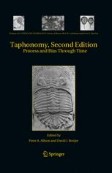Search
Search Results
-
Family Dibrachicystidae (Echinodermata: Rhombifera) from the “Middle” Cambrian of the Barrandian area, Czech Republic
A slightly crushed but otherwise nearly complete specimen of the recently described rhombiferan echinoderm genus Vizcainoia Zamora and Smith,
2012 is...
-
At the dawn of the aerobic biosphere: The effect of oxygen on the development of biota in the Proterozoic and Early Paleozoic
The distinctive features of biota at successive stages of its development in the Proterozoic and Early Paleozoic are analyzed. Based on this analysis...
-
Heckerocrinus, a new substitute generic name for fossil crinoid Bockia Hecker 1940 (Echinodermata: Crinoidea) non Reisinger 1924 (Vermes: Turbellaria)
Heckerocrinus nom. nov., a new generic name of fossil Ordovician crinoid, is proposed for preoccupied fossil generic name Bockia Hecker
1940 non... -
Development of symmetry and asymmetry in the early evolution of the echinoderms
Development of pentameral symmetry in echinoderms occurred by coiling and closing up of bilateral asymmetrical trimeral metamery, characteristic of...
-
Marine Sclerobiofacies: Encrusting and Endolithic Communities on Shells Through Time and Space
The concept of sclerobiofacies is defined herein as suites of sclerobiont encrusters and endiont borers (collectively sclerobionts) preserved on...
-
Carinolithidae fam. nov., Carinolithes bohemicus sp. nov. and Slehoferites slehoferi gen. et sp. nov. – new hyolithid taxa from the Bohemian middle Cambrian (Skryje-Týřovice Basin, Czech Republic)
The hyoliths Slehoferites slehoferi gen. et sp. nov. and Carinolithes bohemicus sp. nov. are described from carbonatic nodules and shale at different...

-
Comparative Taphonomy and Sedimentology of Small-Scale Mixed Carbonate/Siliciclastic Cycles: Synopsis of Phanerozoic Examples
Small scale cycles deposited over 10–100 kyr are a common component of Phanerozoic shelfal deposits. A combination of detailed outcrop analysis and...
-
Combinatorial model for the formation of body plans in higher metazoan taxa: Paleontological insight
The body plans of higher metazoan taxa were formed during a short time (on the geological time scale) by combination of the previously developed...
-
Biodiversity and taphonomy of the Early Cambrian Guanshan biota, eastern Yunnan
The Guanshan biota from eastern Yunnan (Cambrian Series 2, early Stage 4) is a Burgess Shale-type fossil biota with abundant exceptionally preserved...
-
Assessing the Role of Skeletons in Early Paleozoic Carbonate Production: Insights from Cambro-Ordovician Strata, Western Newfoundland
The trend in the abundance of skeletal organisms does not exhibit a monotonic rise beginning with the Cambrian Explosion, but rather has oscillated...
-
The cambrian substrate revolution and early evolution of the phyla
Evidence from Precambrian carbonate and siliciclastic sedimentary structures indicates that in marine settings before the Cambrian conditions of...
-
Morphology, ontogeny, and heterochrony in lower and middle Cambrian Gogiids (Eocrinoidea, Echinodermata) from Guizhou Province, China
Gogiid eocrinoids from the Lower Cambrian (Balang Formation — Guizhoueocrinus ) and basal Middle Cambrian (Kaili Formation — Sinoeocrinus , Globoeocrinus ...
-
Establishment of aromorphic organization: Causes and conditions
Aromorphoses appear based on specialization of ancestral taxon in a narrow adaptive zone. Aromorphic evolution is accumulation and coordination of...
-
Stratigraphic and geographic distribution of acrotretids (Brachiopoda, Lingulata) in the Middle and Late Cambrian
The analysis of the taxonomic composition and distribution of acrotretids (Brachiopoda) in the Middle Cambrian and early Late Cambrian shows that, in...
-
The oldest stylophoran echinoderm: a new Ceratocystis from the Middle Cambrian of Germany
A new stylophoran ( Ceratocystis prosthiakida sp. nov.) from the early Middle Cambrian of the Franconian Forest (north-east Bavaria, Germany) is...

-
Pelmatozoan echinoderms from the Cambrian–Ordovician transition of the Iberian Chains (NE Spain): early diversification of anchoring strategies
Three new echinoderm taxa representative of biodiversification across the Cambrian-Ordovician transition in the Iberian Chains are described in this...
-
Development of the trophic structure of Vendian and Early Paleozoic marine communities
Major trophic links are reconstructed for the Vendian and Early Paleozoic. A hypothesis of the predominant development of extracorporeal or skin...
-
Appearance and evolution of marine benthic communities in the Early Palaeozoic
The development of marine benthic communities in the Early Palaeozoic occurred mainly in the shallow water epicontinental seas. It included those...
-
New Early Cambrian eocrinoids from the Iberian Chains (NE Spain) and their role in nonreefal benthic communities
The Early Cambrian echinoderm-sponge meadows, which colonized shallow carbonate-siliciclastic platforms, have received relatively little study...
